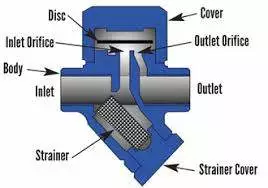Major Types and Installation of Steam Traps or Drain Valves
The basic function of steam traps is to release condensate water, gas, carbon dioxide as quickly as possible, and minimize the leakage of steam simultaneously. There various types of drain valves, each with different functionality.
Steam traps can be divided into three types as follows according to different operating principles.
Mechanical type: Function when the water level of the condensate water inside steam trap changes.
Mechanical type includes:
Free ball float trap: A steam trap with a closed, hollow, cylindrical body,
Inverted bucket steam trap: Opens up or down.
Thermostatic: Action when the liquid temperature changes.
Bi-metal type: Bi-metal sensitive element
Pressure type: Use corrugated pipe or ink box as sensitive element, be injected with volatile liquid.
Thermodynamic: Action according to the change of thermodynamic property of the liquid.
Disc trap: Under the same pressure, different velocities of liquid and gas will generate different static pressure and dynamic pressure, which will change the motion of the disc.
Impulse trap: Different temperatures of the condensate water will bring different pressures between two-stage restriction orifice, which will change the motion of the valve clack.

Installation Precaution of Steam Traps / Drain Valves:
1.Globe valves should be set in the front and back of the steam trap. Between the steam valve and the glove valve in the front of it, a filter must be set in order to prevent contamination of condensate water clogging up the steam trap.
2.For checking if the trap works properly, a test pipe has to be set between the steam valve and the glove valve in the back of it. If a large amount of vapour is given off when opening the test pipe, it means the steam trap is broken.
3.Setting by-pass pipes is for discharging a large amount of condensate water during start-up time and decreasing the load on the steam trap,
4.Steam trap should be set on the bottom of the equipment when it is used for draining condensate water, in case the water stores in the equipment.
5.Install as close to the drain point as possible, otherwise air or vapour will store in the pipe in front of the steam trap.
6.If the pipeline of the main pipe is way too long then the solution of discharging water should take into consideration.
Mechanical type includes:
Free ball float trap: A steam trap with a closed, hollow, cylindrical body,
Inverted bucket steam trap: Opens up or down.
Thermostatic: Action when the liquid temperature changes.
Bi-metal type: Bi-metal sensitive element
Pressure type: Use corrugated pipe or ink box as sensitive element, be injected with volatile liquid.
Thermodynamic: Action according to the change of thermodynamic property of the liquid.
Disc trap: Under the same pressure, different velocities of liquid and gas will generate different static pressure and dynamic pressure, which will change the motion of the disc.
Impulse trap: Different temperatures of the condensate water will bring different pressures between two-stage restriction orifice, which will change the motion of the valve clack.

Installation Precaution of Steam Traps / Drain Valves:
1.Globe valves should be set in the front and back of the steam trap. Between the steam valve and the glove valve in the front of it, a filter must be set in order to prevent contamination of condensate water clogging up the steam trap.
2.For checking if the trap works properly, a test pipe has to be set between the steam valve and the glove valve in the back of it. If a large amount of vapour is given off when opening the test pipe, it means the steam trap is broken.
3.Setting by-pass pipes is for discharging a large amount of condensate water during start-up time and decreasing the load on the steam trap,
4.Steam trap should be set on the bottom of the equipment when it is used for draining condensate water, in case the water stores in the equipment.
5.Install as close to the drain point as possible, otherwise air or vapour will store in the pipe in front of the steam trap.
6.If the pipeline of the main pipe is way too long then the solution of discharging water should take into consideration.
Previous: Application of triple offset two-way hard sealing butterfly valves
Next: An analysis of valve market in China (Part one)
Next: An analysis of valve market in China (Part one)




